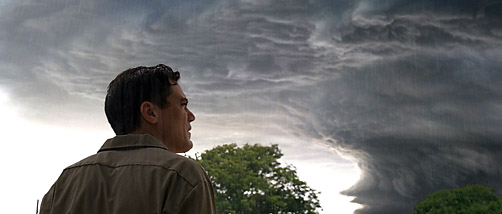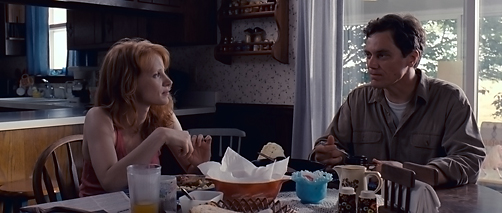|
On
an
open property, a construction worker named Curtis (Michael Shannon) is
worried
about the storm clouds looming over his land. He lives with his wife
Samantha (Jessica
Chastain) and their young daughter, who is deaf. Curtis starts
suffering from
reoccurring nightmares, where he and his daughter are being attacked.
This is
coupled with his increasingly irrational behaviour. He insists on
locking his
dog outside and is intent on building an outdoor shelter for his family
to
protect them from when he believes the storm will arise. This is
despite how
tight their money has become, particularly when they are expecting to
pay for
their daughter’s operation. As Curtis investigates his own health and
the medical
history of his family, increasing pressure is placed on his
relationships with
his colleagues and also his wife. She continues to suffer because she
cannot
keep up with her increasingly distant and distracted husband.

A
haunting atmosphere dominates this slow burning and methodically
produced
psycho-thriller. The motif of a storm, as a metaphor for the internal
pressure
of the mind, is not a new concept. It’s a classic Shakespearean symbol,
used to
evoke physical and emotional tension for the characters. This is
precisely the
brand of horror that Take Shelter strives
for, investing heavily in emotional paranoia, as well as post-9/11
angst and
uncertainty. What is most refreshing for a thriller of this kind is the
restraint that director Jeff Nichols brings to the narrative. The start
of the
picture is the shakiest because it insists on taking us directly into
the mind
of the character. We’re involved with two or three different dream
sequences,
where birds drop out of the sky, furniture is turned upside down and a
dog
bites Curtis. The latter is the most rattling because the lines between
what is
real and imagery are blurred. The other dreams are problematic because
they
feel like they belong to a separate picture, like a cheesy M. Night
Shyamalan horror
film. It weakens the realism and the belief in the psychology of the
central
character Curtis. Thankfully, Nichols lets the tension build slowly but
visibly
in his characters. His control reminds us that less is more and that
the unknown
is most frightening. There are scenes in Take
Shelter that are achingly slow to unfold but the tension is
efficiently realised
because of the quality of the direction and the performances. In one
late scene,
Nichols relies solely on diegetic sound and the reverse camera shots of
Curtis
and Samantha during a conversation. The quietness here is more
unnerving and riveting
than anything happening outside of the house. This is a leisurely paced
film
that tests our patience but its rewards are invaluable.

One
of
other major testing factors in this film is our inaccessibility to the
central
character. Michael Shannon has face that rarely moves in expression and
that
alone ask us how much we are going to sympathise with him. The film
improves
immeasurably, almost to a breaking point of tension, as we become more
involved
with his irrationality and his fearful uncertainty. The script that
Nichols
wrote himself is smart because it knows how to raise the stakes for
Curtis in
an unstable climate but equally unreliable economy too. It’s
increasingly
apparent in Shannon’s performance that there’s a distant void of a man,
who is cold
but seemingly ready to explode. Chastain is a perfect contrast because
she’s
far more emotive and sympathetic. She understands the power of a
close-up shot like
few other actresses. As with The Tree of
Life (2011), she shows us how brittle her character is, not through
verbal
explosiveness, but the most subtle and gentle of facial expressions.
She brings
so much feeling to this role. I hope she is rewarded early next year
for her recent
performances. Collectively, both of these tortured characters make us
question
whether it is better to survive and live in fear or to die peacefully.
If this
sounds daunting, there’s a quietly funny scene where this is humorously
visualised. After Curtis purchases several gas masks and an oxygen tank
for his
daughter, he makes his family sit with him in the shelter. The wide
shot of the
family mounted up together shows us their isolation but also the
occasional
absurdity of overt paranoia. Sometimes in the worst situations, all you
can do
is laugh. And this very rich thriller strikes some painful, nervous
laughter. It’s
one of the most mesmerising thrillers released this year.
|